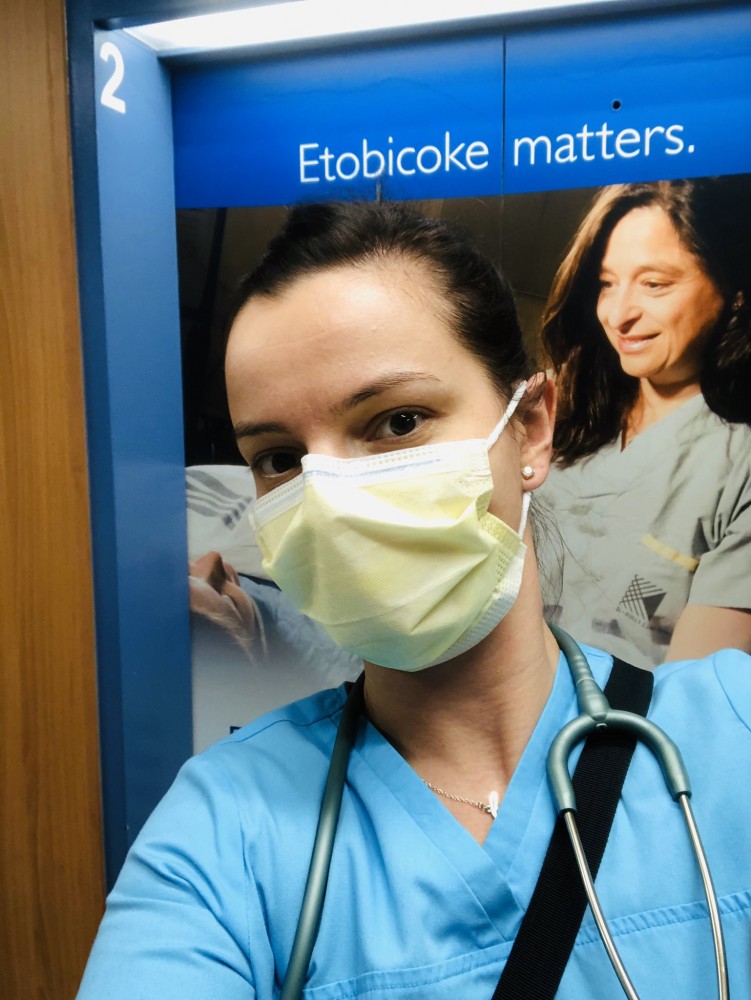
‘It feels like the calm before the storm’: local MPP moonlights as nurse to fight COVID-19
She’s fought for legislation to curb the opioid crisis.
She’s joined the fight against those committing the heinous crime of human trafficking.
And now, Natalia Kusendova, the Progressive Conservative (PC) MPP for Mississauga Centre has returned to her roots as a nurse and joined the front-line battle against COVID-19.
By her own description, she’s a Type-A personality that likes to be where she is needed most.
Right now, that’s in the emergency room.
The novel coronavirus and the disease it causes, COVID-19, has been spreading across the world, like “fire through dry grass” as New York State Governor Andrew Cuomo put it. New York, the hardest hit area of the United States is being buried beneath a wave of infection that has created chaos in the state’s hospital system and left 1,941 people dead as of Wednesday.
Ontario has yet to see such numbers, and health officials and politicians hope that we never do — currently Ontario has 2,392 confirmed cases of COVID-19 and 37 deaths — but there is an eerie feeling of unease in local hospitals.
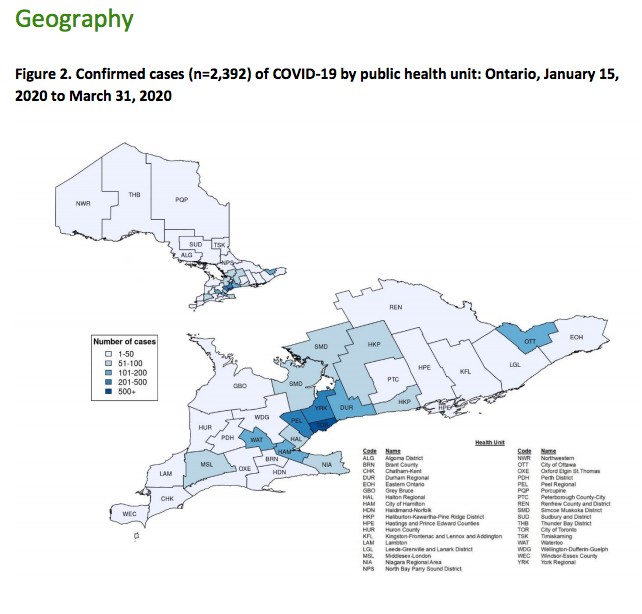
The populous GTA has seen the lion's share of Ontario's COVID-19 cases.
With Queen’s Park adjourned until July, Kusendova is taking her energy back to Etobicoke General, where she worked full-time as a registered nurse before being elected in 2018. When she entered the hospital last week — through a back basement entrance reserved for staff under new pandemic rules — there was clearly a common thought lingering in the nurses’ minds.
“What people are saying is it feels like the calm before the storm,” she tells The Pointer. “What staff are saying is that we’re two or three weeks ahead of Italy, or other epicentres of COVID, so it is going to get busy and it is going to get much more crowded.”
In Italy, one of the hardest hit regions of the world, there are more than 105,000 cases of COVID-19 and more than 13,000 people have been killed by the virus. Canada only has a fraction of these numbers, sitting at 9,613 confirmed cases as of Wednesday, but the highly contagious nature of COVID-19 means that when the numbers start to rise, they rise fast.
Etobicoke General, which is part of the William Osler Health System, is prepared, Kusendova says. While not an official assessment centre for COVID-19 — a centre is located at Osler’s Peel Memorial in Brampton — COVID-19 positive people have arrived at the building, and the hospital is set up to screen these people accordingly.
“The protocol is quite stringent, it’s quite different from what emergency rooms used to look like.”
For staff who work in the building, immediately upon entering the basement entrance, nurses and other healthcare providers are met by two masked security officers who screen them.
Do you have a fever? Do you have a cough? Do you have any other symptoms? Have you travelled recently?
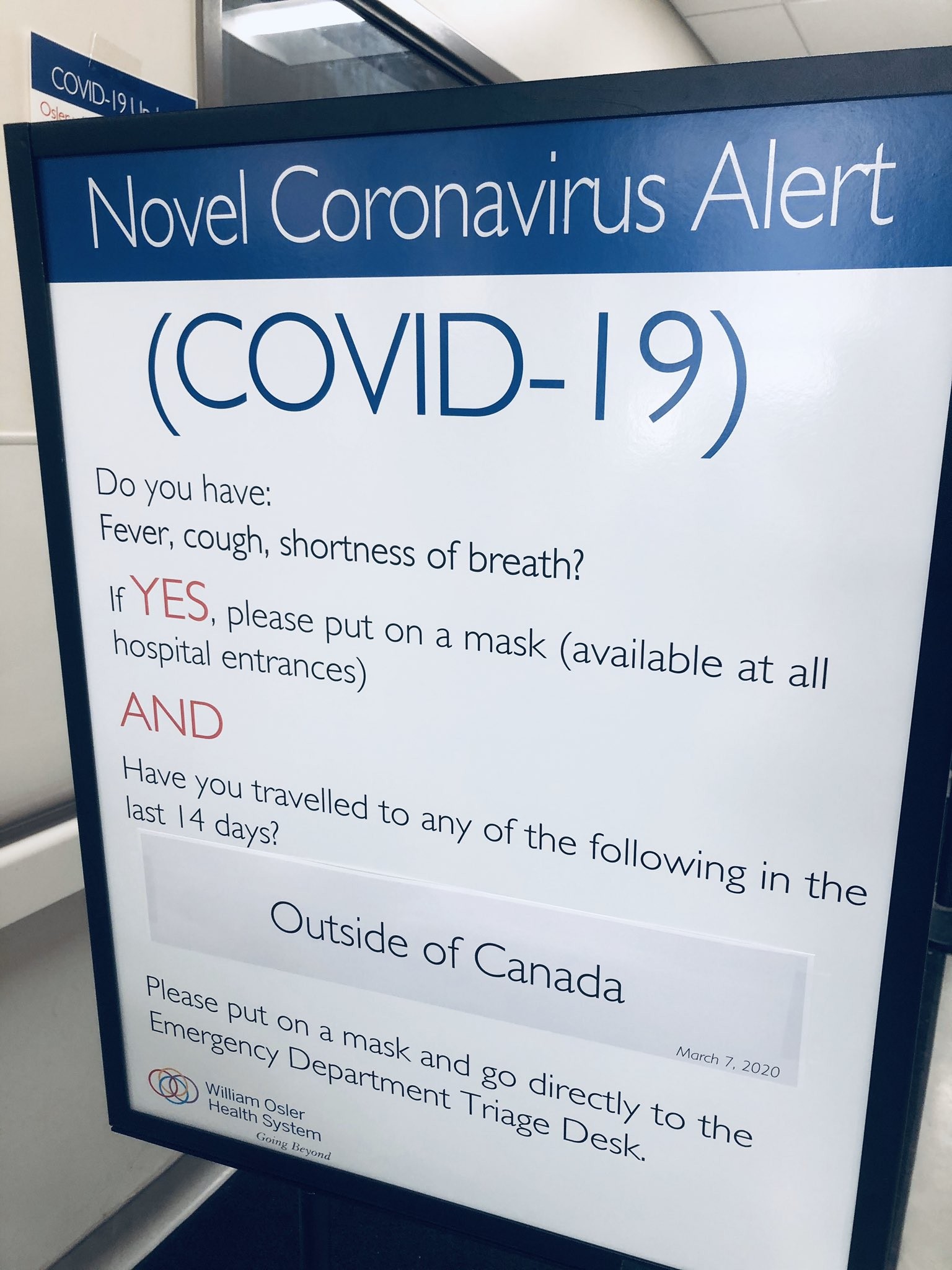
“Once I answered no to all those questions they made me wash my hands with sanitizer, they gave me a mask and some gloves and there was a sign-in sheet, and then they told me the shortest way to now go to my department,” Kusendova explains.
Inside the hospital, things are oddly calm. Like all hospitals and long-term care facilities across the province, Etobicoke General has implemented a no visitor policy. Unless you’re the parent of a sick child, or someone is dying, there are zero exceptions.
Similar strict guidelines are in place for patients who enter the emergency department. People are screened and then split into COVID and non-COVID patients.
“If they’re non-COVID then they get a sticker that says ‘screened’ and they proceed to triage and normal protocols as per usual,” Kusendova explains.
For those who are potentially infected with the incredibly contagious virus, they are escorted through a different entrance, and kept away from everybody else. It seems like something only seen in Hollywood pandemic films, but these extreme precautions are the only way to prevent the virus from slipping through the doors and spreading through the inclosed hospital environment like wildfire.
“They get escorted right away through a different entrance, so they’re immediately separated from the rest of the patients, to an isolated area where all the proper precautions are taken and where staff are specifically trained on how to do the COVID swab, the COVID testing, and how to provide care in isolation,” Kusendova tells The Pointer.
On Friday, Kusendova took part in a training exercise for intubating a patient who is “code blue” — someone whose heart is failing and needs to be resuscitated immediately — something that will be required for the most critical COVID patients.
“That’s really important that we do that, that we do simulations before we actually get to that level where we will be actively resuscitating patients who are dying from COVID, because there are special isolation protocols that every single person who goes into that room needs to be aware of, so it’s always good to practice ahead of time.”
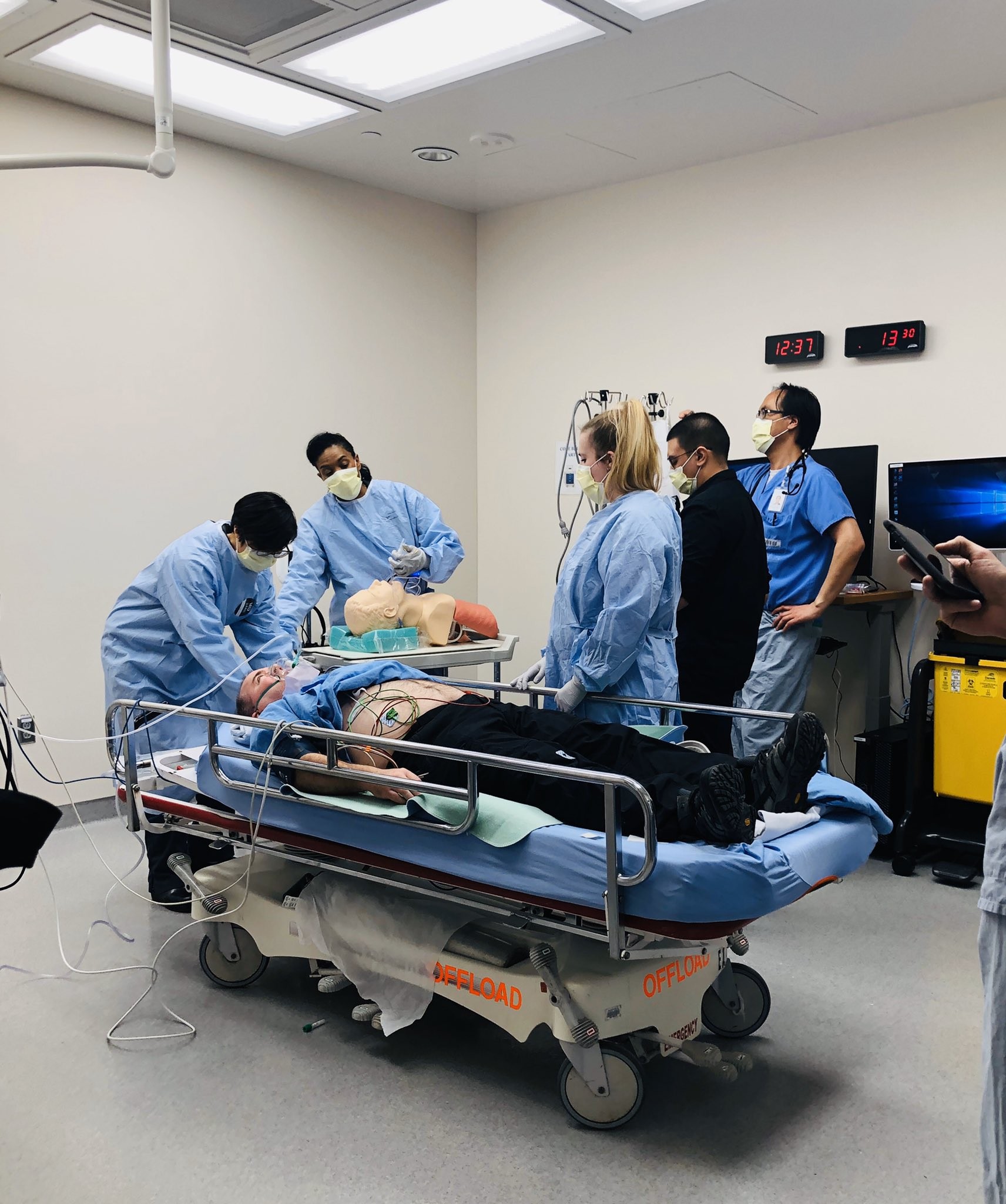
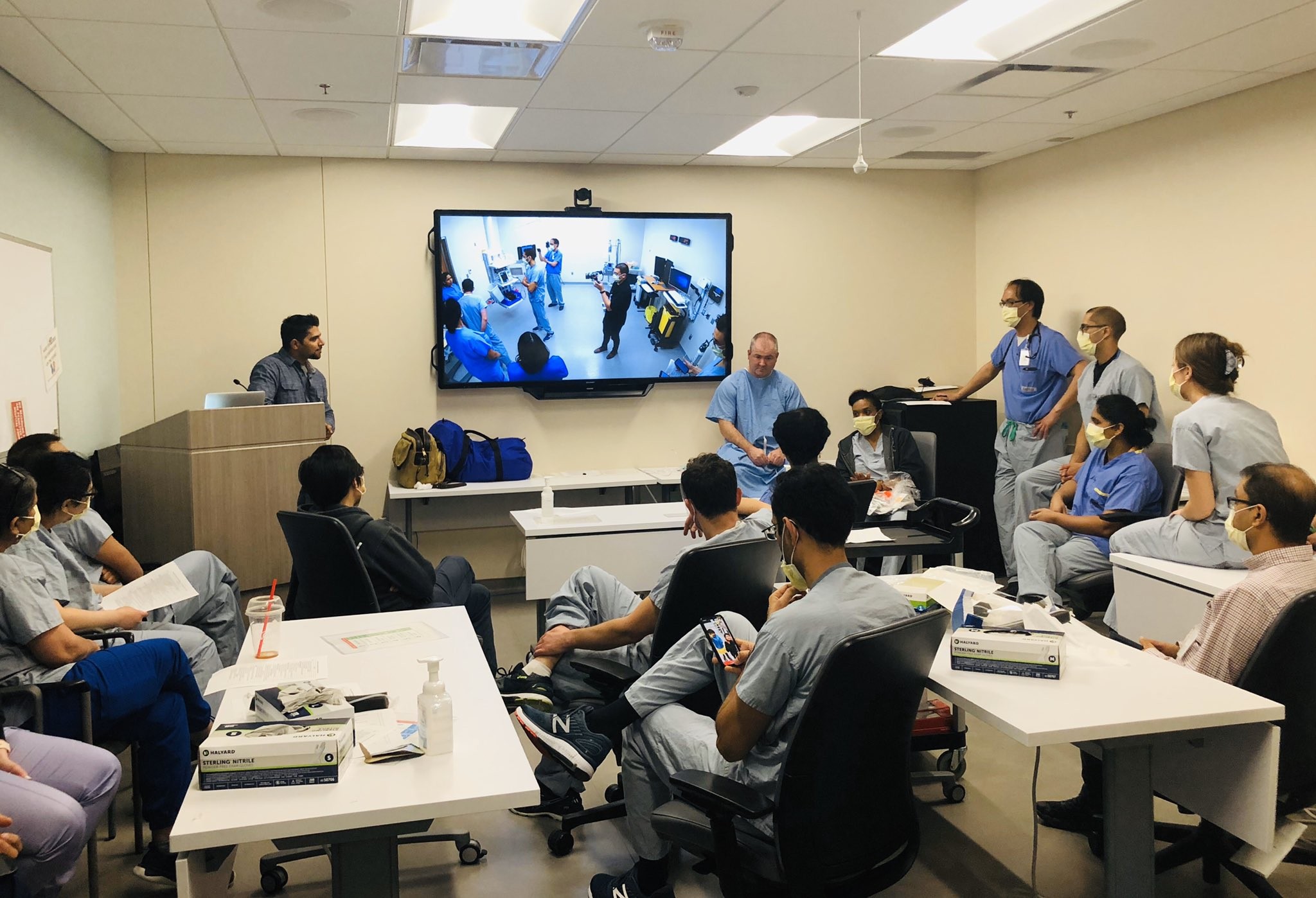
Staff at William Osler's Etobicoke General take part in a training exercise to practice skills for intubating a critically ill patient, something that will be needed when treating serious cases of COVID-19.
Ironically, when speaking to The Pointer on March 26, she says her shift that week was perhaps one of the easiest she’s had in a while.
“All my colleagues and the nursing staff were saying, you know, knock on wood, don’t say that it’s not busy because as soon as we say that in the emergency room it gets busy,” she says.
Ontario is currently in the midst of an unsettling spike, which, if it continues, could start to overwhelm local healthcare systems. Ontario’s numbers have increased threefold over the last week — fivefold when looking at the numbers for Peel Region.
These rising numbers means more people will be seeking assistance in local hospitals. For Kusendova, she says there’s one lingering concern among frontline healthcare providers, the supplies of personal protective equipment (PPE).
There was enough when she arrived for her shift last week, and she says there was a comfortable amount of supplies still in the stores, but she knows that is not the case for hospitals across Ontario.
Stories of nurses being assigned only two protective masks for an entire shift (typically masks are changed when dealing with different patients), and reports out of hard hit areas suggest that if Ontario and Canada don’t prepare for the incoming wave of COVID-19 patients, they too will experience harmful shortages of PPE.
Premier Doug Ford and the province have repeatedly stressed they are working hard to ensure a proper supply of not only PPE, but ventilators as well — the machine used to treat serious cases of COVID-19. However, it’s unclear when much of this needed equipment will arrive due to the fact that jurisdictions across the world are trying to get their hands on the same resources.
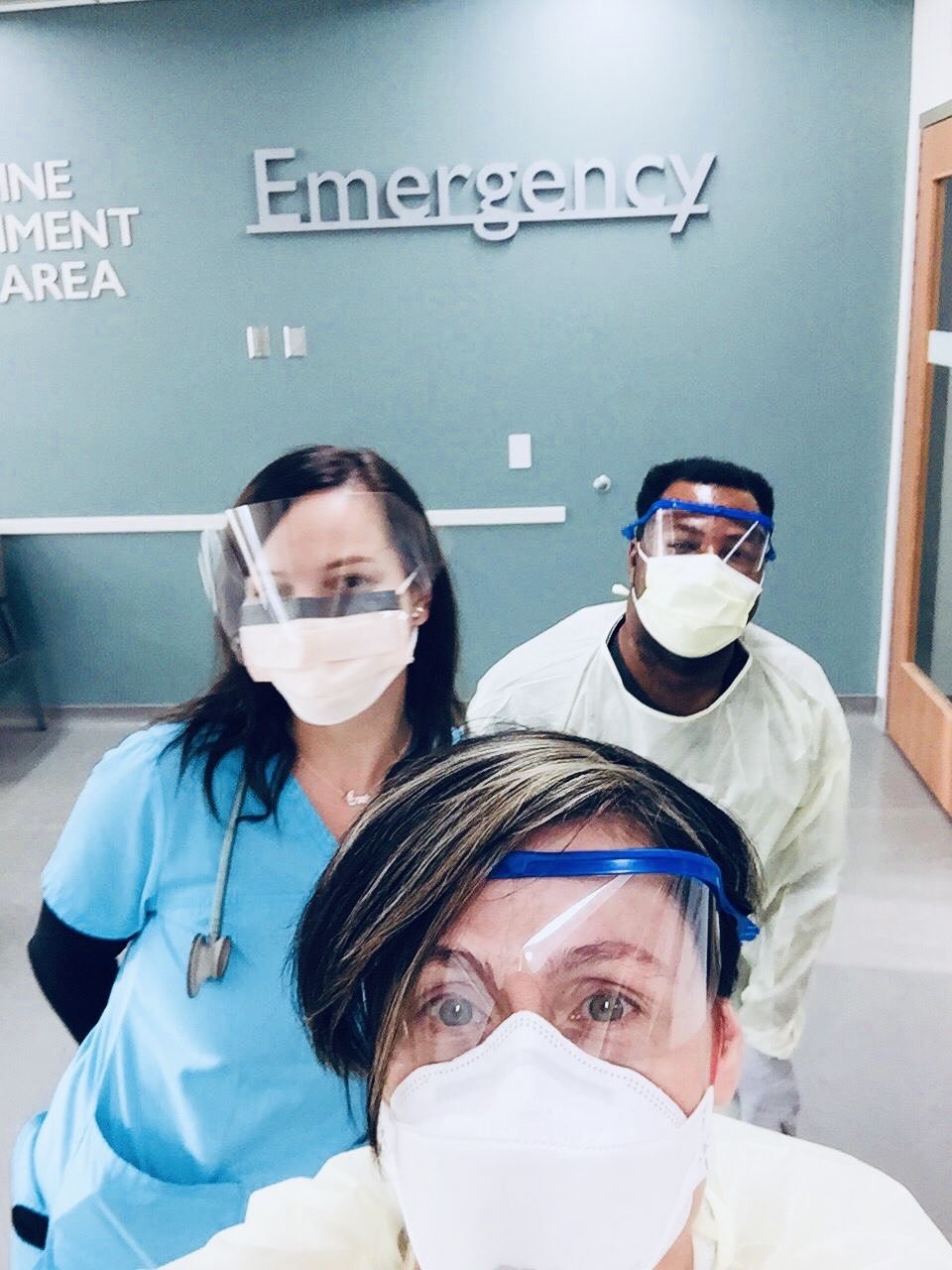
Kusendova (left) says she was comfortable with the supply level of PPE at Etobicoke General during her shift last week, but knows that other hospitals in Ontario are facing shortages of needed supplies.
“We just don’t know when those supplies are coming. I know some of those supplies are sourced locally and others are sourced internationally,” Kusendova says. The MPP has also taken to social media, not only spreading the provincial message urging businesses like tattoo parlour, nail salons, and any others that use PPE to donate them, but also putting out personal calls for needed equipment.
“Meanwhile, some hospitals are well-stocked and have supplies, [but] I’ve been hearing that this is not the case for all Ontario hospitals especially some more smaller hospitals in more rural communities. So I’m really trying to advocate and be a little bit of a bridge between our ministries to see how we can access some emergency stockpiles and to make sure that our frontline workers are protected.”
The upper levels of government have invested large sums into increasing the stores of PPE, including $75 million announced as part of a $17 billion relief package from the provincial government, and on March 31, Prime Minister Justin Trudeau announced $2 billion would be put toward additional medical supplies for the future, noting that right now Canada has what it needs “for the foreseeable future.”
However, it’s a line that rubs uncomfortably against what is being heard from the front lines. In a release from the Registered Nurses Association of Ontario (RNAO), the advocacy groups notes it is hearing reports of PPE shortages across the system, an issue that governments must “urgently address.”
“We are in a war and the enemy is the COVID-19 virus. This is a ravaging pandemic that affects each and all of us at home and abroad. Together, we can and must win. Our success will be measured by how well we come together as a people, how we protect our health-care workers, and how we save lives. Tragically, we will lose too many loved ones due to COVID-19, but our goal must be that we will not lose even one patient or health-care worker that could have been saved if we had the proper PPEs or the ventilators to care for them,” a March 25 news release reads.
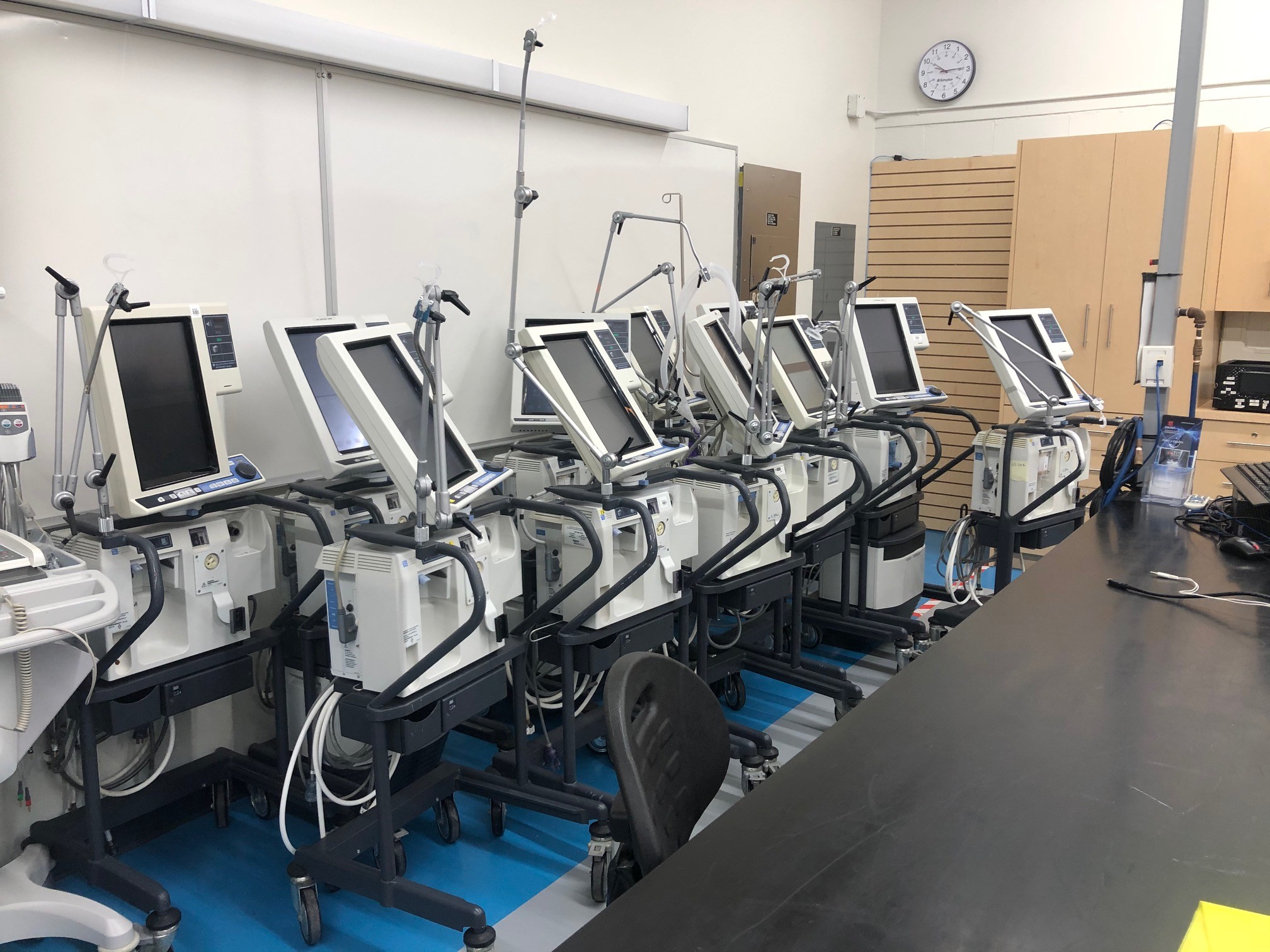
Ventilators like these are crucial in saving the lives of critically ill COVID-19 patients.
However, the next day, the RNAO applauded the provincial government’s efforts when its March 26 aid package was announced, but noted more could still be done, especially when it came to the number of ventilators Ontario could potentially need to treat critically ill COVID-19 patients.
“This pandemic has exposed gaps in our health system. We applaud the government for responding quickly to help fill the gaps we know exist. However, we are only in the early days and more financial investments will be needed,” states RNAO CEO Dr. Doris Grinspun. “While the province announced it has purchased 300 ventilators, the actual need is at least 10 times greater – and there is no time to waste. The lives of thousands of people are at stake,” adds Dr. Grinspun.
“Even with everyone working on this very hard, I know that there are some shortages in some of the hospitals, so how do we bridge that gap and how do we take supplies from one area and bring them to one another,” Kusendova says. “Those are questions that we really didn’t have to deal with for a very long time and so those are questions that are coming up and the situation is progressing day by day, hour by hour.”
Similar to efforts during wartime, both the provincial and federal governments have enlisted the help of local businesses that are able to assist with the manufacturing of PPE and other supplies like hand sanitizer. Many businesses have stepped forward. Earlier this month, alcohol distilleries like Dixon's (who recently delivered sanitizer to the Brampton Fire department), Spirit of York and Reid’s distillery have all shifted to make hand sanitizer, and Bauer, the hockey-equipment giant, announced this week it will begin manufacturing face shields for first responders.
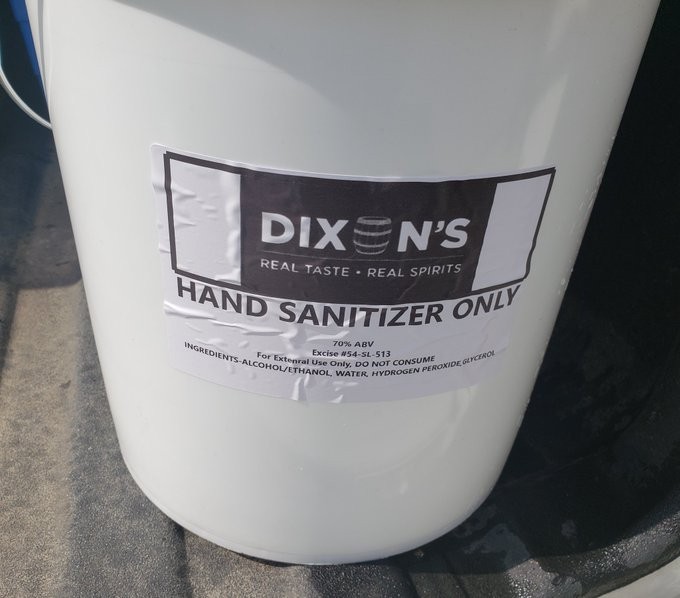
A load of hand sanitizer delivered to the Brampton Fire department from Dixon Spirits.
This type of production is essential as many previously existing supply chains for PPE have been disrupted by the coronavirus. In January, Taiwan banned the export of PPE in order to keep supplies in-country to battle the virus. Last week, the European Union followed suit in an effort to keep as much PPE on the continent as possible. The news came about a week before British Prime Minister Boris Johnson announced he too had tested positive for the new coronavirus along with two of his aides.
For Toronto and much of southern Ontario, being cut off from the European Union was particularly disruptive as many of the hospitals in the area relied on a single 3M production plant in the United Kingdom for much of their PPE. To make matters worse, the majority of PPE is manufactured in China and other parts of Southeast Asia — where the virus first began — and the Chinese government has been purchasing most of the PPE before it can be exported. This has particularly impacted Canada’s access to the necessary N95 respirator masks that protect nurses and other front line workers from the airborne particles that spread COVID-19 from infected patients.
No shortages have been announced locally, but in an effort to stockpile needed supplies, the William Osler Health System has announced a PPE collection drive encouraging local businesses who have surplus supplies to donate them should a surge in demand be seen.
“Personal protective equipment is critical to ensuring the health and safety of our patients, staff and physicians, and never has it been more important than it is right now as we fight the spread of COVID-19,” says Kiki Ferrari, Executive Vice President, Clinical Operations for William Osler Health System. “Osler staff and physicians are working tirelessly to ensure we keep our patients and the community healthy, and we are committed to providing our teams with the supports and equipment they need for safe, high-quality care delivery.”
“I’m trying to brainstorm those ideas of how we can stretch our supply chain as much as possible,” Kusendova says, noting she would be calling local dentists, nail salons and other businesses to hunt for donations of PPE. “At times of need we all need to step up and think outside the box and just help each other.”
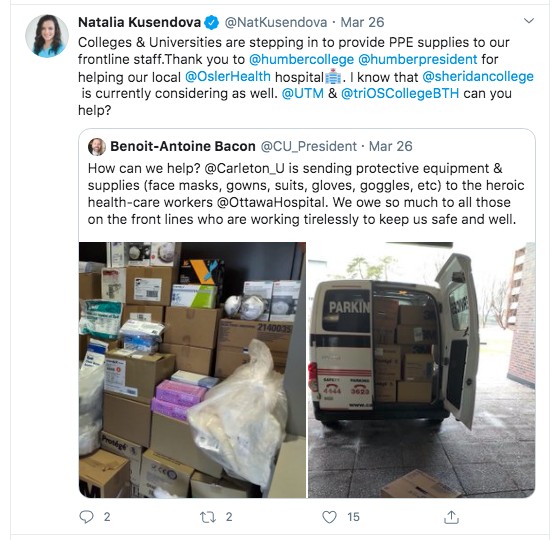

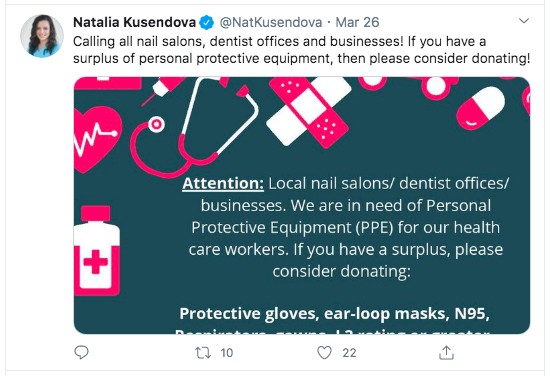
Kusendova has taken to Twitter frequently to request donations of personal protective equipment.
The risk to healthcare providers and first responders is particularly significant. As the first point of contact in the fight against COVID-19, without the proper protections, they are the most at risk for contracting the virus.
According to numbers from the International Council of Nurses, in Italy, one of the world’s worst hit areas by COVID-19, healthcare workers make up 9 percent of those infected. Based on confirmed cases as of April 1 in Italy, it means more than 9,500 healthcare workers are infected. The high rate of infection among these providers is particularly concerning because as COVID-19 strains healthcare resources, these essential workers are required to stay off the job for 14 days to prevent infecting their colleagues, which can only weaken the battle against the virus.
Similar reports are starting to appear in Ontario as well. Last week it was reported that 13 frontline healthcare workers in Toronto had tested positive for COVID-19. Then, on March 25, Brampton West Liberal MP Kamal Khera, also a nurse, had followed the same path to assist on the frontline against COVID, shared that she had tested positive for the virus.
Despite that, Kusendova is showing resilience in the face of mounting uncertainty.
“I don’t feel scared, I’m not nervous, I signed up to be a nurse,” she says. “Even prior to COVID there are certain risks with that profession so every time I go into the emergency room I’m dealing with increased risks to my health, so that’s something I was aware of when I signed up into nursing.”
She admits her mother is certainly more worried than she is, and returned to the ER despite her mom’s calls not to.
However, the young MPP admits she is perhaps in a better position to help than some of her colleagues, who, along with worrying about the increased risks posed by the novel coronavirus while on the job, also have to worry about bringing it home to their children.
“Especially in our cultural communities in the Region of Peel, some of my nursing colleagues, they have elderly parents staying with them at home, and they have young children in those intergenerational households,” Kusendova says. “So for them it poses a bigger challenge.”
Kusendova has shown significant strength in the face of COVID. Ahead of her shift on March 24, she visited a local clinic to donate blood, just another small thing to help. But she admits the uncertainty that hangs over the future of the COVID-19 pandemic does get to her. Like the weather, the forecast for the next few months could be sunny, or plagued by storms.
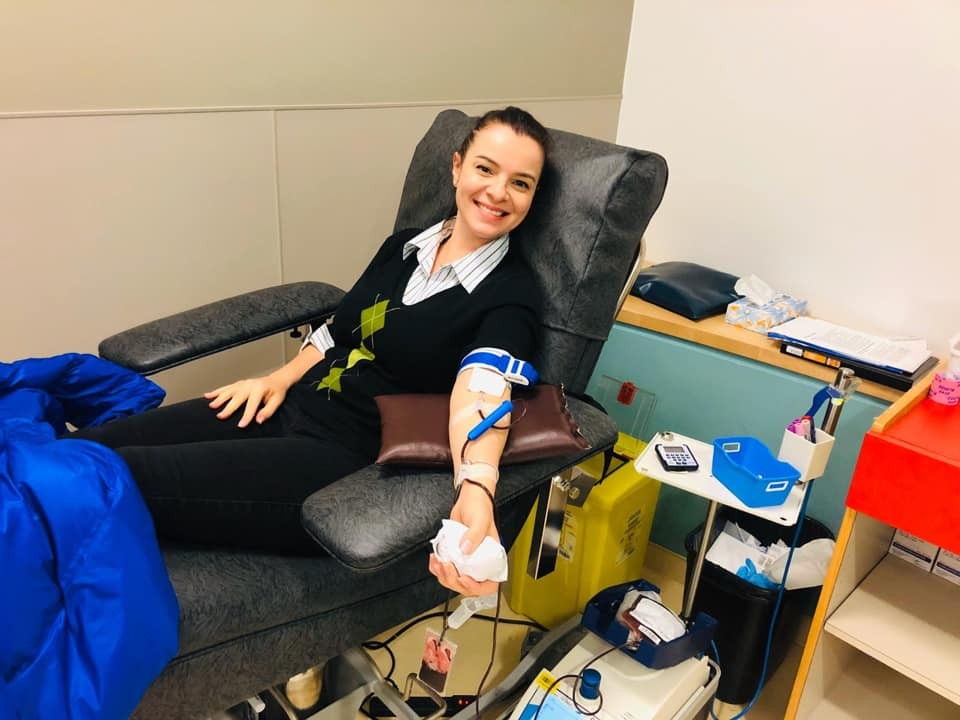
Kusendova donates blood ahead of a nursing shift last week.
In Wuhan, China, ground zero of the COVID-19 pandemic, following months of severe lockdown the city is about to ease some of the restrictions starting next week. However, as one city appears to be taking a small breath of fresh air, on the other side of the world, New York City is being buried beneath a wave of illness that has infected approximately 47,000 people and killed nearly 1,000. Recent grim reports from the White House predict that even with strict physical distancing measures, the country could still see between 100,000 and 240,000 people die from the virus before the pandemic ends.
“The coronavirus is attacking societies at their core,” reads a recent report from the United Nations, which has labelled COVID-19 one of the biggest threats to global security since the organization was formed 75 years ago, and predicts “enhanced instability, enhanced unrest, and enhanced conflict” across the world as a result.
“The biggest thing is there are so many unknown unknowns, right?,” Kusendova says. “So, for us, even as a government, even as we’re trying to plan for the future we don’t know what that future is going to look like because we don’t know if this is going to last a month, two months, a year, we have really no way of foreshadowing that…no government in this world that could have foreseen this or been prepared for this.”
The next few weeks will be very telling of how the pandemic will play out in Ontario, and even as the province tries to ramp up production and procurement of PPE and ventilators in preparation for a worst case scenario, there is always the lingering question, will it be enough?
“I think only time will tell, I think we have enough for now, but again it depends how long this is going to go on for,” Kusendova says. “Right now, we’re just trying to do the best we can with the resources we have.”
When she’s not in the emergency room, Kusendova continues to monitor her Queen’s Park staff, many of whom are working from home, and is fielding calls from her constituents in Mississauga, the typical role of a provincial politician when the world isn’t turned upside down by a deadly virus.
It’s something she enjoys quite a bit, but right now, she knows where she is needed most.
“When I’m sitting at home and answering phone calls, it’s great, I’m serving my constituents, but I like to be involved and I like to go where I’m needed and right now, I think my skills are well utilized in the emergency room,” she says.
Email: [email protected]
Twitter: @JoeljWittnebel
COVID-19 is impacting all Canadians. At a time when vital public information is needed by everyone, The Pointer has taken down our paywall on all stories relating to the pandemic to ensure every resident of Brampton and Mississauga has access to the facts. For those who are able, we encourage you to consider a subscription. This will help us report on important public interest issues the community needs to know about now more than ever. You can register for a 30-day free trial HERE. Thereafter, The Pointer will charge $10 a month and you can cancel any time right on the website. Thank you
Submit a correction about this story


